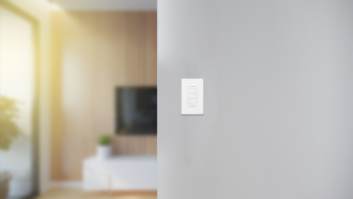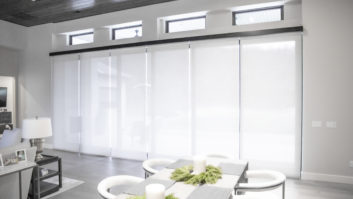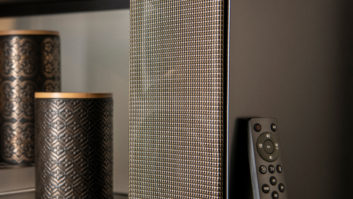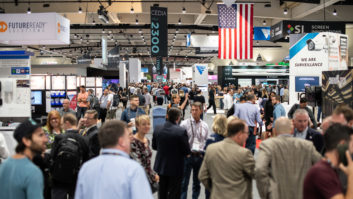There are electronic systems contractors who take pride in their retrofit integration expertise, while others see it as a necessary evil in a tough housing market. Fortunately, for both groups there are now more and more new products that are designed to make their retro work a little easier.

Before and after pictures of a recent retrofit project from Big Sky HTI in Great Falls, Montana. Note the transformation from early 1980s family room to a more contemporary media room with 5.1 surround sound, over-the-mantel LCD display, and computer workstations.
According to Brian Righetti, design sales manager at Wilshire Home Entertainment in Los Angeles, retrofits have become the predominant type of project for his company. “With the economy, people in Southern California aren’t moving as much. We work with builders for access to those homes where people are choosing to remodel instead of moving,” he said.
And it’s not just the California market. David Rogers, owner of Dallas Sight and Sound in Texas, has found that he, too, has been doing a greater number of retrofit projects. “We love retrofit projects,” he said. “Any installation challenges they might present are outweighed by the fact that we have much better control of the overall schedule of the project, and that allows us to set more realistic expectations and deliver on them without being dependent on other trades.”
Maryland-based Gramophone also has seen an increase in retrofit projects due to market conditions. The integration firm’s field account manager Andrew Davis said that these projects can present difficulties in determining how to get proper wiring from room to room or to a home run location. “From an install perspective, we can wire anything,” he said. “However, at what cost and, with the age of a house or construction methods, it might require the need to patch and paint walls?”
But Davis has found that wireless mesh network-capable devices from companies such as Control4 and Sonos can be effective when the project requires minimal wiring and sources can be pinpointed without major expansion needs. But, he cautioned, that these systems can be more limited than Gramophone premier vendors such as Crestron.
“With Sonos, their product is really designed for multi-zone musical enjoyment of streamed audio from Sirius, Internet Radio, MP3s, and services like Pandora. This might be perfect for the client, but when wanting to fully control the home theater or external devices like a CD player or FM radio, it can be beyond its intended design,” he said.
PRODUCTS YOU CAN USE TODAY
There are an increasing number of products being developed with retrofit installation specifically in mind. Ingersoll Rand’s Schlage LiNK is one such affordable home-management solution that has been marketed as easy to install and set up in existing homes. The system is scalable, allowing for a variety of additional Z-Waveenabled devices to be added to the system after initial installation. According to Steven Samolinski, solution manager for Schlage LiNK, a single LiNK system will support more than 200 devices, including Trane’s (also part of Ingersoll Rand) Remote Energy Management Thermostat.
Also on the security side is Honeywell, which has been focusing on wireless solutions as a cost-effective way to work with retrofit homes or systems without the typical costs or difficulties. Honeywell recently introduced video real-time monitoring to its Total Connect line of products. Home and business owners can monitor and view events or threats via iPhone, iPad, BlackBerry, or other smart phone. Additionally, users can arm/disarm systems and be notified when kids return home from school, water leaks occur in the home, or when packages or house workers arrive.
Ryan Arp, owner of Enhance Living Solutions in Chattanooga, Tennessee, has done some extensive retro work, most of it with Control4. “We did some strategic planning for the retrofits and broke the system into modules or small racks scattered throughout the house. This allowed us to only require a network wire between the racks and made our fishing to the displays/speakers pretty short. All the lighting was Control4 as well,” he said. “I just picked up Sonos, and that’s pretty much all I’m going to use now for distributed audio.”
Cory Plummer, owner of Home A/V Solutions in Portland, Maine, says he’s not a big fan of retro, for several reasons. “I’m not a good carpenter, drywaller, or painter,” he noted. However, Plummer recently become a Lutron HomeWorks dealer, and he’s hoping that Radio RA will allow him to do more retro lighting projects.

Unique Home Solutions, of Cincinnati, installed NuVo’s Renovia, which just started shipping in April, during the product’s beta-test phase. These are photos of the project’s Site Analysis Tool at work, along with the preliminary placement of the Renovia SourceHub.
Lighting control has always been a logical choice for retrofit projects, thanks to its use of wireless communication. LiteTouch, which was once heavily focused on the new construction market, has introduced new products to support existing homes with no lighting control and also LiteTouch owners who want to efficiently add on guest rooms, closets, bathrooms, etc. to an existing, wired system.
“By adding the LiteTouch C2000+ card to any 5000LC CCU, an ESC can gain the ability to add wireless communication into the existing system,” said Angie Larson, vice president of sales at LiteTouch. “Hybrid Wall Box Dimmers/Relays can be added to any location not currently connected to the original Lite- Touch system, allowing for whole-home control of all locations regardless of specialty or conventional wiring.”
In addition to adding the wireless capability, the LiteTouch System can be upgraded to include a new FIVEk CCU, a modular card-based processor that delivers the latest functionality without the need to rewire.
Jeff Townsend, president of Big Sky HTI in Great Falls, Montana, believes that the simplest products to retrofit are lighting control products that utilize a wireless mesh network such as ZeeWave or ZigBee. “They are easy to install and are fairly inexpensive, because they are a one-to-one replacement with existing switches,” he said.
NUVO AND RUSSOUND ARE NOW SHIPPING
What really grabbed the headlines this past year were competing multi-room retrofit-focused audio products from Russound and NuVo that both utilize existing power lines to distribute an audio signal from room to room. After a big build up, both products are finally shipping to dealers and distributors.
Dan Ciupe, CEO of Chicago-based Residential Networks, was among the first to install Russound’s Collage and has found that the product will help him to target new clients who are deciding to upgrade versus move, as well upgrade existing clients who already have basic systems to multi-room systems.
“We have an existing client that owns a condo in downtown Chicago,” Ciupe explained. “He had a Denon receiver with four zones of audio, and also a separate surround system. We installed three Collage keypads in half a day, no damage. We got rid of his old receiver/speaker selector/IR kit, too. Now he has easier access to his music plus we added more audio sources with metadata to his system.”
So far Ciupe has found that Collage is robust, with good communication over the power lines and no failures. But, he worries, concrete walls could present some challenges, as it would be too much trouble to cut the walls and provide electrical power and install speakers.
Ciupe was pleased with the clean installation, the easy set up requiring no programming, the simple user interface, and the ability for the client to troubleshoot on his own. Next, he hopes to see an app that would allow clients to control their system from an iPhone or iPad.
Matt McCormick, sales manager at Cincinnatibased Unique Home Solutions, installed NuVo’s Renovia, which just started shipping in April, during its beta-test period. He was pleased with the flexibility of the system.
“What’s interesting with this NuVo product is that there’s no zone restrictions,” he said. “If you want to put in four zones, great, then put in four zones. My project was eight zones. In the past, with NuVo, it was either six zones or nothing.”
According to McCormick, his first Renovia installation was relatively flawless. “One thing great about the Renovia product is that you can hide the doublegang box that has to house the amplifier very easily, because you can use an outlet that’s behind a couch or table in the room,” he explained. “Aesthetically it’s really easy to do. That outlet doesn’t even need to be in that particular room either. In this house, the garage shared a wall with the family room. So rather than put that double-gang box in the family room, we just flipped it around backwards and put it in the garage.”
The Renovia install only took two days, for an eight-zone system, according to McCormick. “We came very close to making it a one-day project, and we had one installer there, because our electrician was willing to pull both low-voltage and line-voltage cable for us. Usually if we would have done eight zones of audio in someone’s house, we would have had two installers there for four to five days, pulling wire and possibly cutting more drywall.”
Despite these positive product developments, retrofit often comes down to practical experience and common sense. Bob Lydecker, owner of Lydecker & Co., in Providence, Rhode Island, does a significant amount of retrofit work, mostly in historic homes. As a result, he has learned some invaluable lessons that can help to keep a retrofit project stay on schedule.
“Measure three times before you cut anything,” Lydeck said. “Always drill tiny test holes and scope out what’s in the wall first. Remember that however long you estimate the job will take, it will always take longer.” Karen Sussman is a freelance writer in Carmel, Indiana.





